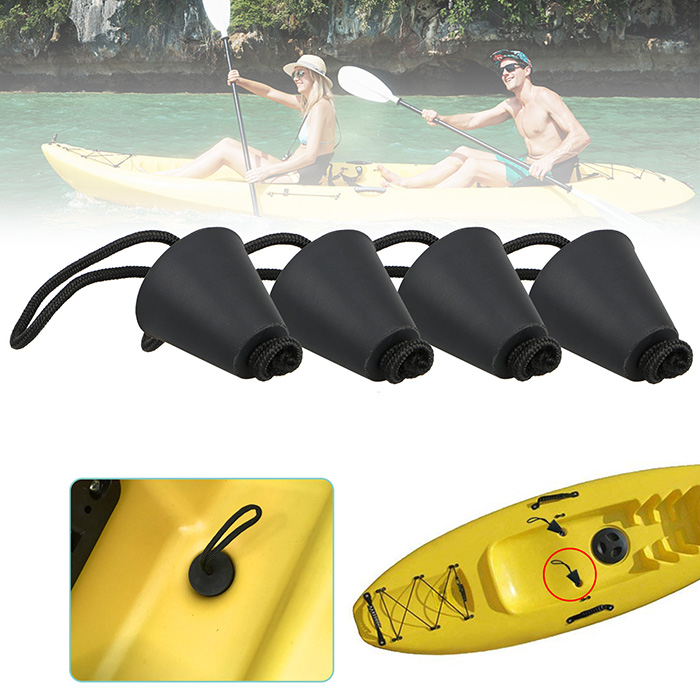Contents
Plugs for Kayaks: When, Why, and How to use
Scupper plugs for kayak are a fun and easy project, but they may seem a little mysterious at first.
Plugs for your scupper holes can be as simple as some dowels with some homemade flanges, or as complicated as an insert that is custom made to fit the hole in the deck perfectly. Scupper plugs for kayaks keep water from splashing into your boat when you’re on the water but also keep things from falling into those openings too.
Scupper Plugs sit in scupper holes that are designed to drain your kayak of water. These kayak scupper plugs are hollow so water can easily flow through them. Scupper Plugs are attached to the underside of kayaks with straps that have cords on either end so you can adjust their position, depending on where you want them in your scupper holes. Plugs are usually made from soft yet durable rubber or foam that is easy to fit in scupper holes. Plugs are the most effective way to stop water from getting into your kayak, so let’s take a look at why they are used and what they do.
Why Are Plugs Used?
Kayak scupper plugs are used for several different reasons, and first and foremost they should be used for safety.
- Scupper plugs prevent water from coming into your kayak and sinking it.
- Plugs also help to make paddling more comfortable as they reduce turbulence caused by waves splashing against the sides of your kayak.
- Scupper plugs keep those on board dryer, warmer, and safer as their kayak won’t fill up with water up to their waist.
When using kayak plugs?

Plugs can be used to close up your scupper holes, preventing water from draining but also the flow of spray and keeping it dry. Plugs require some knowledge on how they work and why some are better than others. Plugs for kayaks generally fall under two categories:
-
Classic Plugs
Traditional kayak scupper plugs have to be dropped in one by one, before dropping them each time it’s necessary to reach around and make sure they’re still there. If you didn’t follow the sinking plug down, chances are high that on some occasions, such as long days on the water, or when emptying your boat (after fishing) it will get lost. When you add up this extra hassle plus if you had bad plastic while putting them in, these plugs can turn into something quite annoying and inconvenient over time.
Plastics come in different shapes and sizes: round plugs that go into round scupper holes. Plugs of this kind can be reused if they do not get damaged, but it’s still a pain to remove and install them repeatedly and sometimes forget how and where you put them! Plunging Plugs will however allow the departure without having to gather all those plugs first, so no need to worry about losing one at any time on an open ocean kayaking tour.
-
Plunger Plugs
Are generally more convenient for keeping it dry inside your kayak. Plunger Plugs will easily slide inside the scupper holes and is generally easier to install and remove. You can also attach a leash onto Plungers Plugs so you don’t lose it when removing it. The Plunger plug works by opening up on one end which we can call the “valve”. To close your Plunger Plug simply press down on the top of that valve until you hear a click. Opening it back up again is as easy as pressing on the other side until you hear another click.
Plunging Plugs: It slides in like a plunger across the scuppers but requires two hands to open them back up. Plunging Plugs are the easiest to install and remove, it is also more convenient for keeping your kayak dry. This plug can be attached to a string so you don’t lose them while emptying your boat after fishing! Plunging Plugs are just as comfortable on ocean kayaking tours or short excursions on inland waters.
Summary: Plunger Plugs are more convenient and better for personal use and will not require much effort to install and remove. Plungers Plugs come in different colors (such as red-yellow) which allows you to easily see if they’re open or closed at all times without having to look down into the scupper holes every time you check. Plastics used are generally standard Plastics that can be purchased just about anywhere. Plunging Plugs are usually longer than Plugs used for Classic Plugs, but the length won’t affect their usability in any way.
How Do You Use kayak scupper plugs?

Plugs for kayaks can be used with most types of single or folding kayaks. If you have a two-person sit-on top kayak, scupper plugs for kayaks are not recommended since the scuppers are designed to drain any water that may get in your boat. Plugs are provided with both open cockpit and closed cockpit boats.
Kayak scupper plugs are placed into scupper holes so they will not let water onto the deck of the sit-on-top kayak. Kayakers use them to prevent accidents when storing their boats as well as trying to keep water from entering the hull while cruising on flatwater or fishing. Plugs hold up better transport than other means such as wet towels.
Plugs are put into the scupper before you paddle. Water will then drain safely out of your boat instead of onto the bottom of your vessel and then into it. They must always remain dry. Otherwise, this would cause them to grow mildew and rot over time. Plugs are also used to keep rainwater from entering your kayak.
This can be important if you want to remain dry inside, making it more comfortable for the kayaker. Plugs are removable so they do not have to stay in all of the time. It is recommended that they only be installed when needed. They should then be taken out or removed as soon as possible once you are done using them. Scupper plugs will usually hold up well during transport unless not secured properly.
How do I choose the right plugs?
- When deciding which Plugs are most suitable for your kayak, you should consider how many plugs you will need, where Plugs are positioned in your scupper holes, and if Plugs can be adjusted or tightened to suit your needs.
- When purchasing Plugs for your kayaks they must be safe, strong, and durable so they don’t break when you place them in scupper holes, but most importantly they need to be comfortable so you will want Plugs that won’t damage or cut your feet if submerged in water while paddling.
-
You might want Plugs that come with straps on either side so they can be tightened, which would keep Plugs in position. Plugs that come with straps on either side are also simpler to attach to the underside of your kayak than Plugs that only have one strap with one cord.
It’s best not to use Plugs without straps attached since this makes them more difficult to attach to the underside of your kayak. The best Plugs will be made from soft yet durable rubber or foam designed especially for Plunging through water so water does not damage or cut Plugs.
- Plugs can be made from foam or soft yet durable rubber and should be easy to fit into scupper holes.
- Plugs that are made from foam are lighter than Plugs that are made from rubber, but Plugs which come with straps on either side should be strong enough to remain pegged in place while being submerged in water or during transportation.
- Some kayakers prefer Plugs that are filled with air so they float if dropped into your kayak, so consider whether you will want Plugs filled with air once you’ve purchased them and then refilled them when required for use.
- Scupper Plugs should only be used when transporting kayaks on top of car or while being transported by hand since Plugs can slide out of place during transportation if they have one strap instead of two.
FAQ
What To Do If A Plug Is Missing?
It is best to use a second plug as a backup if you lose one while paddling or transporting your boat. You can then take out that old plug as soon as possible.
Why is water in a kayak so bad?
The water inside a kayak is no good since Plugs that are not filled with air may crack or break after being submerged in water. Water can also become trapped between Plugs and the underside of your kayak which means this water will be stuck underneath your Plugs, so you will have to move Plugs around until the trapped water has trickled out through scupper holes on either side of the Plugs.
Are kayak drain plugs universal?
A kayak drain plug is not universal. Plugs for kayaks come in various sizes and the Plugs that are most suitable for you Kayak will depend on what model of Plugs you have. Plugs that are universal are designed to fit into any Placement of the scupper hole, but this doesn't mean they're always your best option.
Conclusion
Scupper Plugs are an essential accessory for any kayaker. Plugs will help keep a kayak dry inside and will allow you to enjoy your time on the water more comfortably. Plugs come in many different shapes and sizes so they should be suited to your individual needs.

